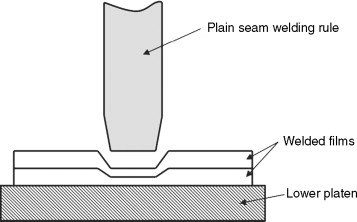Producing Technologies and Materials
There are two main fabrication techniques applicable to welding PVC materials in the producing of inflatable products:
– High Frequency welding – abbreviated HF or HF welding.
Assembly of products is made by high frequency and with pressure between welding electrodes.
Material oscillation between the electrodes causes the material to heat up. Pressure and heat bond the product parts. At the same time, pressure and heat cause thinning of the material at the weld spot. It is the most economical technology. The products made by this technology are the cheapest. Products are lightweight.
If you are looking for the cheapest products, choose products with the HF tag.
– Hot air welding – OS abbreviated according to visible Overlaped Seams.
 It is hand-made technology. Technology is therefore more
It is hand-made technology. Technology is therefore more  laborious and more expensive. Assembly of products is made with a flow hot air and joining parts by pressure. Products made with this technology have longer durability than products made by technology HF. Products are lightweight.
laborious and more expensive. Assembly of products is made with a flow hot air and joining parts by pressure. Products made with this technology have longer durability than products made by technology HF. Products are lightweight.
If you are looking for the more durable products, choose products with the OS tag.
Comparing technologies:
In all processing of PVC, it is important to minimize to risk of direct thermal degradation. Generally is important to ensure the minimum practicable increase of the heat history of the material in welded area. While HF technology overheats the entire thickness of the material, using OS technology only thin layers of material will be melted, which will then be bonded. There is no thinning of the material at the weld spot as with HF technology. The weld point is flat and the material thickness is double at the weld point.
PVC materials degrade by aging. Degradation is caused by:
– exposure to sunlight
– the action of chlorine compounds used for disinfection in swimming pools
– mechanical stress etc.
Another reason for product damage is when customer pulling products on the ground and contact with concrete.
Therefore, over time, these factors cause natural damage to products at the weakest points. The weakest point of products made by HF technology is just the weld point. In contrast, products made by OS technology have twice the thickness of material at the weld spot.
Thickness of materials:
The most commonly used material thickness for the production of standard inflatable wheels is 0.75mm. This material thickness is optimal and tested for best product prices and product durability. Beware, some producers reduce the cost of production by reducing the material thickness to 0.7mm – 0.6mm. Material thickness can be measured by the customers. However, a regular customer is unable to detect differences in the quality of equally thick materials. The materials may be of different density and composition. Customer can also compare material density according to net product weight.
In the manufacture of materials are used expensive additives that change and improve their properties such as toughness, abrasion resistance. This means that even materials of the same thickness can have quite different properties and in result different product lifetimes. In order to satisfy all customers, we offer various types of products ranging from the cheapest to the most expensive.
For the most demanding customers we produce tubes with 1.0mm thickness materials.
Find these products with the HD (High Durability) tag.
Handles
The best way to compare our handles and competing handles is by photo. According to visible details, it is possible to determine which handles are used on the cheapest tubes.



